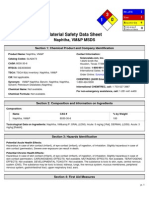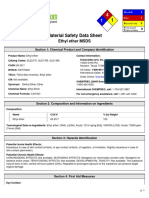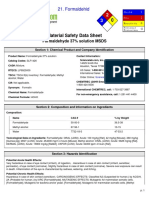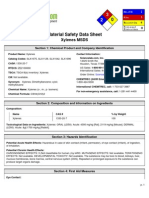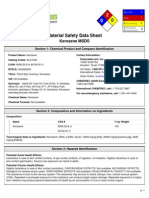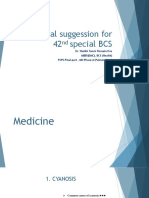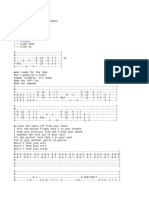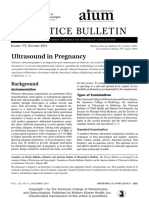Ea Msds
Ea Msds
Uploaded by
api-263411629Copyright:
Available Formats
Ea Msds
Ea Msds
Uploaded by
api-263411629Original Title
Copyright
Available Formats
Share this document
Did you find this document useful?
Is this content inappropriate?
Copyright:
Available Formats
Ea Msds
Ea Msds
Uploaded by
api-263411629Copyright:
Available Formats
p.
1
3
1
0
He a lt h
Fire
Re a c t iv it y
Pe rs o na l
Pro t e c t io n
2
3
0
G
Material Safety Data Sheet
Ethyl acetate MSDS
Section 1: Chemical Product and Company Identification
Product Name: Ethyl acetate
Catalog Codes: SLE2452, SLE2317
CAS#: 141-78-6
RTECS: AH5425000
TSCA: TSCA 8(b) inventory: Ethyl acetate
CI#: Not available.
Synonym: Acetic Acid, Ethyl Ester Acetic Ether
Chemical Name: Ethyl Acetate
Chemical Formula: C4-H8-O2
Contact Information:
Sciencelab.com, Inc.
14025 Smith Rd.
Houston, Texas 77396
US Sales: 1-800-901-7247
International Sales: 1-281-441-4400
Order Online: ScienceLab.com
CHEMTREC (24HR Emergency Telephone), call:
1-800-424-9300
International CHEMTREC, call: 1-703-527-3887
For non-emergency assistance, call: 1-281-441-4400
Section 2: Composition and Information on Ingredients
Composition:
Name CAS # % by Weight
Ethyl acetate 141-78-6 100
Toxicological Data on Ingredients: Ethyl acetate: ORAL (LD50): Acute: 5620 mg/kg [Rat]. 4100 mg/kg [Mouse]. 4935 mg/kg
[Rabbit]. VAPOR (LC50): Acute: 45000 mg/m 3 hours [Mouse]. 16000 ppm 6 hours [Rat].
Section 3: Hazards Identification
Potential Acute Health Effects:
Hazardous in case of ingestion, of inhalation. Slightly hazardous in case of skin contact (irritant, permeator), of eye contact
(irritant).
Potential Chronic Health Effects:
CARCINOGENIC EFFECTS: A4 (Not classifiable for human or animal.) by ACGIH. MUTAGENIC EFFECTS: Not available.
TERATOGENIC EFFECTS: Not available. DEVELOPMENTAL TOXICITY: Not available. The substance is toxic to mucous
membranes, upper respiratory tract. The substance may be toxic to blood, kidneys, liver, central nervous system (CNS).
Repeated or prolonged exposure to the substance can produce target organs damage.
Section 4: First Aid Measures
p. 2
Eye Contact:
Check for and remove any contact lenses. In case of contact, immediately flush eyes with plenty of water for at least 15
minutes. Cold water may be used. Get medical attention.
Skin Contact:
Wash with soap and water. Cover the irritated skin with an emollient. Get medical attention if irritation develops. Cold water
may be used.
Serious Skin Contact: Not available.
Inhalation:
If inhaled, remove to fresh air. If not breathing, give artificial respiration. If breathing is difficult, give oxygen. Get medical
attention if symptoms appear.
Serious Inhalation:
Evacuate the victim to a safe area as soon as possible. Loosen tight clothing such as a collar, tie, belt or waistband. If
breathing is difficult, administer oxygen. If the victim is not breathing, perform mouth-to-mouth resuscitation. Seek medical
attention.
Ingestion:
Do NOT induce vomiting unless directed to do so by medical personnel. Never give anything by mouth to an unconscious
person. Loosen tight clothing such as a collar, tie, belt or waistband. Get medical attention if symptoms appear.
Serious Ingestion: Not available.
Section 5: Fire and Explosion Data
Flammability of the Product: Flammable.
Auto-Ignition Temperature: 426.67C (800F)
Flash Points: CLOSED CUP: -4.4C (24.1F). (TAG) OPEN CUP: 7.2C (45F) (Cleveland).
Flammable Limits: LOWER: 2.2% UPPER: 9%
Products of Combustion: These products are carbon oxides (CO, CO2).
Fire Hazards in Presence of Various Substances:
Highly flammable in presence of open flames and sparks, of heat. Slightly flammable to flammable in presence of oxidizing
materials, of acids, of alkalis. Non-flammable in presence of shocks.
Explosion Hazards in Presence of Various Substances:
Risks of explosion of the product in presence of static discharge: Not available. Slightly explosive in presence of heat. Non-
explosive in presence of shocks.
Fire Fighting Media and Instructions:
Flammable liquid, soluble or dispersed in water. SMALL FIRE: Use DRY chemical powder. LARGE FIRE: Use alcohol foam,
water spray or fog.
Special Remarks on Fire Hazards:
Vapor may travel considerable distance to source of ignition and flash back. When heated to decomposition it emits acrid
smoke and irritating fumes.
Special Remarks on Explosion Hazards:
The liquid produces a vapor that forms explosive mixtures with air at normal temperatures. Explosive reaction with lithium
tetrahydroaluminate.
Section 6: Accidental Release Measures
Small Spill:
Dilute with water and mop up, or absorb with an inert dry material and place in an appropriate waste disposal container.
p. 3
Large Spill:
Flammable liquid. Keep away from heat. Keep away from sources of ignition. Stop leak if without risk. Absorb with DRY earth,
sand or other non-combustible material. Do not touch spilled material. Prevent entry into sewers, basements or confined
areas; dike if needed. Be careful that the product is not present at a concentration level above TLV. Check TLV on the MSDS
and with local authorities.
Section 7: Handling and Storage
Precautions:
Keep away from heat. Keep away from sources of ignition. Ground all equipment containing material. Do not ingest. Do not
breathe gas/fumes/ vapor/spray. Wear suitable protective clothing. In case of insufficient ventilation, wear suitable respiratory
equipment. If ingested, seek medical advice immediately and show the container or the label. Keep away from incompatibles
such as oxidizing agents, acids, alkalis.
Storage:
Store in a segregated and approved area. Keep container in a cool, well-ventilated area. Keep container tightly closed and
sealed until ready for use. Avoid all possible sources of ignition (spark or flame). Moisture sensitive.
Section 8: Exposure Controls/Personal Protection
Engineering Controls:
Provide exhaust ventilation or other engineering controls to keep the airborne concentrations of vapors below their respective
threshold limit value. Ensure that eyewash stations and safety showers are proximal to the work-station location.
Personal Protection:
Safety glasses. Lab coat. Vapor respirator. Be sure to use an approved/certified respirator or equivalent. Gloves.
Personal Protection in Case of a Large Spill:
Splash goggles. Full suit. Vapor respirator. Boots. Gloves. A self contained breathing apparatus should be used to avoid
inhalation of the product. Suggested protective clothing might not be sufficient; consult a specialist BEFORE handling this
product.
Exposure Limits:
TWA: 400 (ppm) from OSHA (PEL) [United States] TWA: 400 from ACGIH (TLV) [United States] TWA: 1400 (mg/m3) from
NIOSH [United States] TWA: 400 (ppm) from NIOSH [United States] TWA: 400 (ppm) [Canada] TWA: 1440 (mg/m3) [Canada]
TWA: 1400 (mg/m3) from OSHA (PEL) [United States]3 Consult local authorities for acceptable exposure limits.
Section 9: Physical and Chemical Properties
Physical state and appearance: Liquid.
Odor: Ethereal. Fruity. (Slight.)
Taste: Bittersweet, wine-like burning taste
Molecular Weight: 88.11 g/mole
Color: Colorless.
pH (1% soln/water): Not available.
Boiling Point: 77C (170.6F)
Melting Point: -83C (-117.4F)
Critical Temperature: 250C (482F)
Specific Gravity: 0.902 (Water = 1)
Vapor Pressure: 12.4 kPa (@ 20C)
p. 4
Vapor Density: 3.04 (Air = 1)
Volatility: Not available.
Odor Threshold: 3.9 ppm
Water/Oil Dist. Coeff.: The product is more soluble in oil; log(oil/water) = 0.7
Ionicity (in Water): Not available.
Dispersion Properties: See solubility in water, diethyl ether, acetone.
Solubility: Soluble in cold water, hot water, diethyl ether, acetone, alcohol, benzene.
Section 10: Stability and Reactivity Data
Stability: The product is stable.
Instability Temperature: Not available.
Conditions of Instability: Heat, ignition sources (flames, sparks, static), incompatible materials
Incompatibility with various substances: Reactive with oxidizing agents, acids, alkalis.
Corrosivity: Non-corrosive in presence of glass.
Special Remarks on Reactivity:
Also incompatible with nitrates, chlorosulfonic acid, oleum, potassium-tert-butoxide, and lithium tetrahydroaluminate. Moisture
sensitive. On storage, it is slowly decomposed by water.
Special Remarks on Corrosivity: Not available.
Polymerization: Will not occur.
Section 11: Toxicological Information
Routes of Entry: Absorbed through skin. Eye contact. Inhalation. Ingestion.
Toxicity to Animals:
WARNING: THE LC50 VALUES HEREUNDER ARE ESTIMATED ON THE BASIS OF A 4-HOUR EXPOSURE. Acute oral
toxicity (LD50): 4100 mg/kg [Mouse]. Acute toxicity of the vapor (LC50): 45000 mg/m3 3 hours [Mouse].
Chronic Effects on Humans:
CARCINOGENIC EFFECTS: A4 (Not classifiable for human or animal.) by ACGIH. Causes damage to the following organs:
mucous membranes, upper respiratory tract. May cause damage to the following organs: blood, kidneys, liver, central nervous
system (CNS).
Other Toxic Effects on Humans:
Hazardous in case of ingestion, of inhalation. Slightly hazardous in case of skin contact (irritant, permeator).
Special Remarks on Toxicity to Animals: LD50 [Rabbit] - Route: skin; Dose >20,000 ml/kg
Special Remarks on Chronic Effects on Humans:
May affect genetic material (mutagenic). May cause adverse reproductive effects. based on animal test data. No human data
found at this time.
Special Remarks on other Toxic Effects on Humans:
Acute Potential Health Effects: Skin: May cause skin irritation. Eyes: Causes eye irritation. May cause irritation of the
conjunctivia. Inhalation: May cause respiratory tract and mucous membrane irritation. May affect respiration and may cause
acute pulmonary edema. May affect gastrointestinal tract (nausea, vomiting). May affect behavior/central nervous system
(mild central nervous system depression - exhilaration, talkativeness, boastfulness, belligerancy, vertigo, diplopia, drowsiness,
slurred speech, slowed reaction time, dizziness, lightheadedness, somnolence, ataxia, unconciousness, irritability, fatigue,
sleep disturbances, reduced memory and concentration, stupor, coma), cardiovascular system (peripheral vascular collapse
(shock) - rapid pulse, hypotension, cold pale skin, hypothermia). Other symptoms may include: flushing of face and sweating.
p. 5
Ingestion: May cause gastrointestinal tract irritation with nausea and vomiting. May affect blood, behavior/central nervous
system (CNS depression - effects may be similar to that of inhalation). Chronic Potential Health Effects: Skin: Repeated or
prolonged skin contact may cause drying and cracking of the skin. IngestIon: Prolonged or repeated ingestion may affect
the liver. Inhalation: Prolonged inhalation may affect behavior/central nervous system (symptoms similar to those of acute
inhalation), and cause liver, kidney, lung, and heart damage. It may also affect metabolism, and blood (anemia, leukocytosis).
Section 12: Ecological Information
Ecotoxicity:
Ecotoxicity in water (LC50): 220 mg/l 96 hours [Fish (Fathead minnow)]. 212.5 ppm 96 hours [Fish (Indian catfish)].
BOD5 and COD: Not available.
Products of Biodegradation:
Possibly hazardous short term degradation products are not likely. However, long term degradation products may arise.
Toxicity of the Products of Biodegradation: The product itself and its products of degradation are not toxic.
Special Remarks on the Products of Biodegradation: Not available.
Section 13: Disposal Considerations
Waste Disposal:
Waste must be disposed of in accordance with federal, state and local environmental control regulations.
Section 14: Transport Information
DOT Classification: CLASS 3: Flammable liquid.
Identification: : Ethyl Acetate UNNA: 1173 PG: II
Special Provisions for Transport: Not available.
Section 15: Other Regulatory Information
Federal and State Regulations:
Connecticut hazardous material survey.: Ethyl acetate Illinois toxic substances disclosure to employee act: Ethyl acetate
Illinois chemical safety act: Ethyl acetate New York release reporting list: Ethyl acetate Rhode Island RTK hazardous
substances: Ethyl acetate Pennsylvania RTK: Ethyl acetate Florida: Ethyl acetate Minnesota: Ethyl acetate Massachusetts
RTK: Ethyl acetate Massachusetts spill list: Ethyl acetate New Jersey: Ethyl acetate New Jersey spill list: Ethyl acetate
Louisiana spill reporting: Ethyl acetate California Director's list of Hazardous Substances: Ethyl acetate TSCA 8(b) inventory:
Ethyl acetate TSCA 4(a) final test rules: Ethyl acetate TSCA 8(a) IUR: Ethyl acetate TSCA 12(b) annual export notification:
Ethyl acetate CERCLA: Hazardous substances.: Ethyl acetate: 5000 lbs. (2268 kg)
Other Regulations:
OSHA: Hazardous by definition of Hazard Communication Standard (29 CFR 1910.1200). EINECS: This product is on the
European Inventory of Existing Commercial Chemical Substances.
Other Classifications:
WHMIS (Canada): CLASS B-2: Flammable liquid with a flash point lower than 37.8C (100F).
DSCL (EEC):
R11- Highly flammable. R36- Irritating to eyes. S2- Keep out of the reach of children. S16- Keep away from sources of ignition
- No smoking. S26- In case of contact with eyes, rinse immediately with plenty of water and seek medical advice. S33-
Take precautionary measures against static discharges. S46- If swallowed, seek medical advice immediately and show this
container or label.
p. 6
HMIS (U.S.A.):
Health Hazard: 2
Fire Hazard: 3
Reactivity: 0
Personal Protection: g
National Fire Protection Association (U.S.A.):
Health: 1
Flammability: 3
Reactivity: 0
Specific hazard:
Protective Equipment:
Gloves. Lab coat. Vapor respirator. Be sure to use an approved/certified respirator or equivalent. Wear appropriate respirator
when ventilation is inadequate. Safety glasses.
Section 16: Other Information
References: Not available.
Other Special Considerations: Not available.
Created: 10/10/2005 08:18 PM
Last Updated: 05/21/2013 12:00 PM
The information above is believed to be accurate and represents the best information currently available to us. However, we
make no warranty of merchantability or any other warranty, express or implied, with respect to such information, and we assume
no liability resulting from its use. Users should make their own investigations to determine the suitability of the information for
their particular purposes. In no event shall ScienceLab.com be liable for any claims, losses, or damages of any third party or for
lost profits or any special, indirect, incidental, consequential or exemplary damages, howsoever arising, even if ScienceLab.com
has been advised of the possibility of such damages.
You might also like
- Ethyl Acetate MSDS: Section 1: Chemical Product and Company IdentificationDocument6 pagesEthyl Acetate MSDS: Section 1: Chemical Product and Company IdentificationZachery IngramNo ratings yet
- Msds Ethyl AcetateDocument6 pagesMsds Ethyl AcetateMohammad Taufik Mohar100% (1)
- Ethylbenzene MSDS PDFDocument6 pagesEthylbenzene MSDS PDFyuanitaNo ratings yet
- CikloheksanonDocument7 pagesCikloheksanonmicaziv4786No ratings yet
- MsdsDocument6 pagesMsdsRizki Adwitiyo 'Dito'No ratings yet
- Msds TolueneDocument6 pagesMsds Toluenenirmal_subudhi100% (1)
- Metil AcrilatoDocument6 pagesMetil Acrilatosoulwizard00No ratings yet
- Formaldehyde Solution, Reagnt, ACS MSDS: Section 1: Chemical Product and Company IdentificationDocument7 pagesFormaldehyde Solution, Reagnt, ACS MSDS: Section 1: Chemical Product and Company IdentificationGilang RamadhanNo ratings yet
- FormaldehydeDocument7 pagesFormaldehydeAsih MiniartiNo ratings yet
- Amil AlkoholDocument6 pagesAmil AlkoholJ FadliNo ratings yet
- 2-Butoxyethanol MSDS: Section 1: Chemical Product and Company IdentificationDocument6 pages2-Butoxyethanol MSDS: Section 1: Chemical Product and Company IdentificationMBastawyNo ratings yet
- Material Safety Data Sheet 2,2,4-Trimethylpentane MSDSDocument6 pagesMaterial Safety Data Sheet 2,2,4-Trimethylpentane MSDSBilly T HoNo ratings yet
- Msds HeptaneDocument6 pagesMsds Heptanenirmal_subudhiNo ratings yet
- Petroleum Ether, Boiling Range 90 - 120 C MSDS: Section 1: Chemical Product and Company IdentificationDocument6 pagesPetroleum Ether, Boiling Range 90 - 120 C MSDS: Section 1: Chemical Product and Company IdentificationMichael HarperNo ratings yet
- Msds Etanol 2005Document7 pagesMsds Etanol 2005Puput Trisnayanti Inanto PutriNo ratings yet
- Msds PropanolDocument6 pagesMsds PropanolDasa HaryuwibawaNo ratings yet
- Ethyl Ether MSDS: Section 1: Chemical Product and Company IdentificationDocument6 pagesEthyl Ether MSDS: Section 1: Chemical Product and Company IdentificationAhmad SuhardimanNo ratings yet
- L-Nicotine MSDSDocument6 pagesL-Nicotine MSDSagent4881No ratings yet
- Formaldehid: Formaldehyde 37% Solution MSDSDocument7 pagesFormaldehid: Formaldehyde 37% Solution MSDSMutia Nurul OctaviaNo ratings yet
- Naphthalene MSDS: Section 1: Chemical Product and Company IdentificationDocument6 pagesNaphthalene MSDS: Section 1: Chemical Product and Company IdentificationAdalberto AlvarezNo ratings yet
- MSDS HeksanaDocument6 pagesMSDS HeksanadiantikaNo ratings yet
- BenzinDocument6 pagesBenzinmicaziv4786No ratings yet
- Sodium Ethoxide MSDS: Section 1: Chemical Product and Company IdentificationDocument6 pagesSodium Ethoxide MSDS: Section 1: Chemical Product and Company IdentificationJosé Martín Meza CabillasNo ratings yet
- Formic MsdsDocument6 pagesFormic Msdsapi-263411629No ratings yet
- Msds PDFDocument6 pagesMsds PDFToni ChandraNo ratings yet
- Indikator PPDocument6 pagesIndikator PPNadhil Eka PutraNo ratings yet
- MsdsDocument6 pagesMsdsfrespinosagNo ratings yet
- Msds - Auto I.T KeroseneDocument6 pagesMsds - Auto I.T KeroseneCharith LiyanageNo ratings yet
- Msds N PentaneDocument6 pagesMsds N Pentanenirmal_subudhiNo ratings yet
- Acrylic Acid MSDS: Section 1: Chemical Product and Company IdentificationDocument6 pagesAcrylic Acid MSDS: Section 1: Chemical Product and Company Identificationzaaba100% (1)
- Phenol MSDS: Section 1: Chemical Product and Company IdentificationDocument6 pagesPhenol MSDS: Section 1: Chemical Product and Company IdentificationShabrina Aufar SalmaNo ratings yet
- Msds FenolDocument6 pagesMsds Fenolbenol1987No ratings yet
- Msds KafeinDocument6 pagesMsds KafeinNovia Arinda Pradisty100% (1)
- Msds For KeroseneDocument6 pagesMsds For KeroseneMahadeva PrasadNo ratings yet
- Msds Benzena PDFDocument6 pagesMsds Benzena PDFIrianto Rizaldi FaturrahmanNo ratings yet
- Msds ButanolDocument6 pagesMsds ButanolMaria Regina SudiartaNo ratings yet
- Msds Kloroform - 2Document6 pagesMsds Kloroform - 2bayueriyantoNo ratings yet
- Msds BUTIRALDocument6 pagesMsds BUTIRALSatrio Rekso Hadi PNo ratings yet
- Msds BenzenaDocument7 pagesMsds BenzenaRezaPratamaNo ratings yet
- A Consumerýs Dictionary of Household, Yard and Office Chemicals: Complete Information About Harmful and Desirable Chemicals Found in Everyday Home Products, Yard Poisons, and Office PollutersFrom EverandA Consumerýs Dictionary of Household, Yard and Office Chemicals: Complete Information About Harmful and Desirable Chemicals Found in Everyday Home Products, Yard Poisons, and Office PollutersNo ratings yet
- Hydrogen peroxide uses for the body: 31 5 Minute Remedies! Discover Uses for Hydrogen Peroxide including Mouthwash & Bad Breath, Teeth Whitening, Acne, Ear Wax, Hair, Allergy & Nasal Spray and MOREFrom EverandHydrogen peroxide uses for the body: 31 5 Minute Remedies! Discover Uses for Hydrogen Peroxide including Mouthwash & Bad Breath, Teeth Whitening, Acne, Ear Wax, Hair, Allergy & Nasal Spray and MORERating: 5 out of 5 stars5/5 (1)
- The Health & Safety Guide for Film, TV & Theater, Second EditionFrom EverandThe Health & Safety Guide for Film, TV & Theater, Second EditionRating: 4 out of 5 stars4/5 (1)
- After a Disaster - Information to Help You and Your Family RecoverFrom EverandAfter a Disaster - Information to Help You and Your Family RecoverNo ratings yet
- Dust Explosion and Fire Prevention Handbook: A Guide to Good Industry PracticesFrom EverandDust Explosion and Fire Prevention Handbook: A Guide to Good Industry PracticesNo ratings yet
- Georgia Pest Management Handbook: 2021 Home and Garden EditionFrom EverandGeorgia Pest Management Handbook: 2021 Home and Garden EditionEmily CabreraNo ratings yet
- Hydrogen Peroxide Handbook: Proven Secrets to Optimum Health, Quick Healing, Illness Prevention and Natural Beauty: Homemade, DIY, Natural, #1From EverandHydrogen Peroxide Handbook: Proven Secrets to Optimum Health, Quick Healing, Illness Prevention and Natural Beauty: Homemade, DIY, Natural, #1No ratings yet
- First Aid on the Farm: Natural and Conventional TreatmentsFrom EverandFirst Aid on the Farm: Natural and Conventional TreatmentsNo ratings yet
- VAPING 101: A Q&A Guide for Parents - A Doctor’s Advice on How to Keep Your Teens Safe from the Dangers of VapingFrom EverandVAPING 101: A Q&A Guide for Parents - A Doctor’s Advice on How to Keep Your Teens Safe from the Dangers of VapingNo ratings yet
- Yd903 MsdsDocument3 pagesYd903 Msdsapi-263411629No ratings yet
- Saccharin SodiumDocument6 pagesSaccharin Sodiumapi-263411629No ratings yet
- SfmsdsDocument5 pagesSfmsdsapi-263411629No ratings yet
- Natrium Bikarbonat PDFDocument5 pagesNatrium Bikarbonat PDFJ FadliNo ratings yet
- Yd128 MsdsDocument3 pagesYd128 Msdsapi-263411629No ratings yet
- Stearic Acid MsdsDocument5 pagesStearic Acid Msdsapi-263411629No ratings yet
- Caustic Sada Flakes MsdsDocument9 pagesCaustic Sada Flakes Msdsapi-263411629No ratings yet
- Soda Ash Dense MsdsDocument3 pagesSoda Ash Dense Msdsapi-263411629No ratings yet
- Soda Ash Lite Natural MsdsDocument3 pagesSoda Ash Lite Natural Msdsapi-263411629No ratings yet
- Saccharin MsdsDocument5 pagesSaccharin Msdsapi-263411629No ratings yet
- Caustic Sada Flakes MsdsDocument9 pagesCaustic Sada Flakes Msdsapi-263411629No ratings yet
- Ginasul46p MsdsDocument4 pagesGinasul46p Msdsapi-263411629No ratings yet
- Yd128 MsdsDocument3 pagesYd128 Msdsapi-263411629No ratings yet
- Formic MsdsDocument6 pagesFormic Msdsapi-263411629No ratings yet
- Msds MelicDocument5 pagesMsds Melicapi-263411629No ratings yet
- Aos PDocument4 pagesAos Papi-263411629No ratings yet
- MSDSPJDocument6 pagesMSDSPJapi-263411629No ratings yet
- Msds GlycerinDocument6 pagesMsds Glycerinapi-263411629No ratings yet
- Salter Harris - DAK (Ortho UNS)Document23 pagesSalter Harris - DAK (Ortho UNS)DitaAnggaraKusumaNo ratings yet
- Stems 1-30Document12 pagesStems 1-30api-257611676No ratings yet
- Why Growing Taller AFTER Puberty Is POSSIBLE - Testimonials and TipsDocument2 pagesWhy Growing Taller AFTER Puberty Is POSSIBLE - Testimonials and TipsAniket MitraNo ratings yet
- (FREE PDF Sample) Biology, 13e ISE 13th Edition Kenneth A. Mason - Ebook PDF EbooksDocument25 pages(FREE PDF Sample) Biology, 13e ISE 13th Edition Kenneth A. Mason - Ebook PDF Ebookswaskidaina100% (5)
- PHGY 209 Midterm Fall 1994Document7 pagesPHGY 209 Midterm Fall 1994Felicia ChungNo ratings yet
- Medical Mirror ReportDocument19 pagesMedical Mirror Reportpuru0% (1)
- Magee HombroDocument130 pagesMagee HombroJorge Vargas CatalanNo ratings yet
- Mitochondria in Health and Disease: Ray GriffithsDocument338 pagesMitochondria in Health and Disease: Ray GriffithsMbaye Diaw DIOUM100% (3)
- 7s Strength SpeedDocument52 pages7s Strength SpeedFelipe Rodrigues de Araújo100% (3)
- Bronchospasm During Anaesthesia Update 2011Document5 pagesBronchospasm During Anaesthesia Update 2011hy3pjb1984No ratings yet
- Timeline of Appearance of Life FormsDocument4 pagesTimeline of Appearance of Life FormsMaria Andrea CosicoNo ratings yet
- Anesthesiology InstrumentsDocument31 pagesAnesthesiology InstrumentsYik Ping TanNo ratings yet
- Tension Pneumothorax PDFDocument2 pagesTension Pneumothorax PDFClarissa Aileen Caliva AdoraNo ratings yet
- Emergency Exam4Document7 pagesEmergency Exam4Nader Smadi100% (3)
- Kingdom ProtistaDocument30 pagesKingdom ProtistaQueenie Salas RetesNo ratings yet
- Questions MidtermDocument4 pagesQuestions MidtermReham El-sawyNo ratings yet
- Novel Use of Tranexamic Acid To Reduce The Need For Nasal Packing in Epistaxis (Nopac) Randomised Controlled Trial: Research ProtocolDocument11 pagesNovel Use of Tranexamic Acid To Reduce The Need For Nasal Packing in Epistaxis (Nopac) Randomised Controlled Trial: Research ProtocoltendriayuNo ratings yet
- Science 6 DLP 5 The Path of BloodDocument10 pagesScience 6 DLP 5 The Path of BloodMonica Morales MaañoNo ratings yet
- NCERT BookDocument10 pagesNCERT Bookkaushikray06No ratings yet
- Manual DefibstartDocument71 pagesManual DefibstartgilbertopalmaNo ratings yet
- If A Nerd Removes Her Glasses..... COMPLETEDDocument2,140 pagesIf A Nerd Removes Her Glasses..... COMPLETEDkawaii yoonaNo ratings yet
- 30-Day HIIT ChallengeDocument1 page30-Day HIIT ChallengeAnke AcaNo ratings yet
- Chapman 1978Document5 pagesChapman 1978aneupane465No ratings yet
- Iba Sindh Mdcat Reconduc Test (sindh reconduct 2024)Document22 pagesIba Sindh Mdcat Reconduc Test (sindh reconduct 2024)Dr KnowledgeNo ratings yet
- LECTURE 7 AUTOIMMUNITY AND AUTOIMMUNE DISEASE Part1 PDFDocument20 pagesLECTURE 7 AUTOIMMUNITY AND AUTOIMMUNE DISEASE Part1 PDFMAYANo ratings yet
- 200 Special Topics For 42 BCSDocument187 pages200 Special Topics For 42 BCSRezaul RazibNo ratings yet
- Devils FoodDocument2 pagesDevils FoodSuso Vila DíazNo ratings yet
- Biomechanics - Question PapersDocument22 pagesBiomechanics - Question PapersHey GoogleNo ratings yet
- 175 Ultrasound in Pregnancy PDFDocument16 pages175 Ultrasound in Pregnancy PDFNestor Ferrer100% (1)
- Karoshi PDFDocument6 pagesKaroshi PDFJuanito MaravillasNo ratings yet




